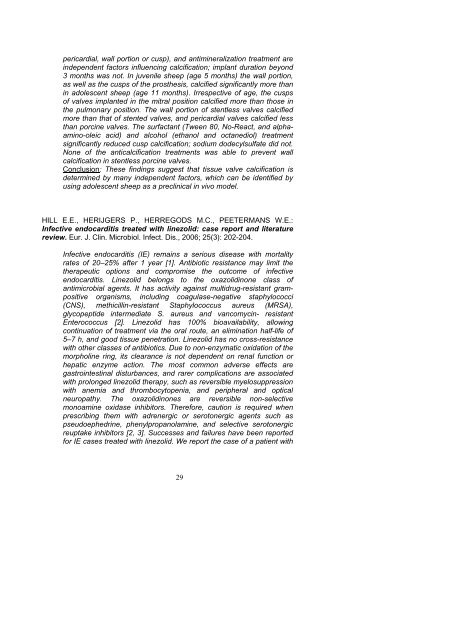2006 - UZ Leuven
2006 - UZ Leuven
2006 - UZ Leuven
You also want an ePaper? Increase the reach of your titles
YUMPU automatically turns print PDFs into web optimized ePapers that Google loves.
pericardial, wall portion or cusp), and antimineralization treatment areindependent factors influencing calcification; implant duration beyond3 months was not. In juvenile sheep (age 5 months) the wall portion,as well as the cusps of the prosthesis, calcified significantly more thanin adolescent sheep (age 11 months). Irrespective of age, the cuspsof valves implanted in the mitral position calcified more than those inthe pulmonary position. The wall portion of stentless valves calcifiedmore than that of stented valves, and pericardial valves calcified lessthan porcine valves. The surfactant (Tween 80, No-React, and alphaamino-oleicacid) and alcohol (ethanol and octanediol) treatmentsignificantly reduced cusp calcification; sodium dodecylsulfate did not.None of the anticalcification treatments was able to prevent wallcalcification in stentless porcine valves.Conclusion: These findings suggest that tissue valve calcification isdetermined by many independent factors, which can be identified byusing adolescent sheep as a preclinical in vivo model.HILL E.E., HERIJGERS P., HERREGODS M.C., PEETERMANS W.E.:Infective endocarditis treated with linezolid: case report and literaturereview. Eur. J. Clin. Microbiol. Infect. Dis., <strong>2006</strong>; 25(3): 202-204.Infective endocarditis (IE) remains a serious disease with mortalityrates of 20–25% after 1 year [1]. Antibiotic resistance may limit thetherapeutic options and compromise the outcome of infectiveendocarditis. Linezolid belongs to the oxazolidinone class ofantimicrobial agents. It has activity against multidrug-resistant grampositiveorganisms, including coagulase-negative staphylococci(CNS), methicillin-resistant Staphylococcus aureus (MRSA),glycopeptide intermediate S. aureus and vancomycin- resistantEnterococcus [2]. Linezolid has 100% bioavailability, allowingcontinuation of treatment via the oral route, an elimination half-life of5–7 h, and good tissue penetration. Linezolid has no cross-resistancewith other classes of antibiotics. Due to non-enzymatic oxidation of themorpholine ring, its clearance is not dependent on renal function orhepatic enzyme action. The most common adverse effects aregastrointestinal disturbances, and rarer complications are associatedwith prolonged linezolid therapy, such as reversible myelosuppressionwith anemia and thrombocytopenia, and peripheral and opticalneuropathy. The oxazolidinones are reversible non-selectivemonoamine oxidase inhibitors. Therefore, caution is required whenprescribing them with adrenergic or serotonergic agents such aspseudoephedrine, phenylpropanolamine, and selective serotonergicreuptake inhibitors [2, 3]. Successes and failures have been reportedfor IE cases treated with linezolid. We report the case of a patient with29

















